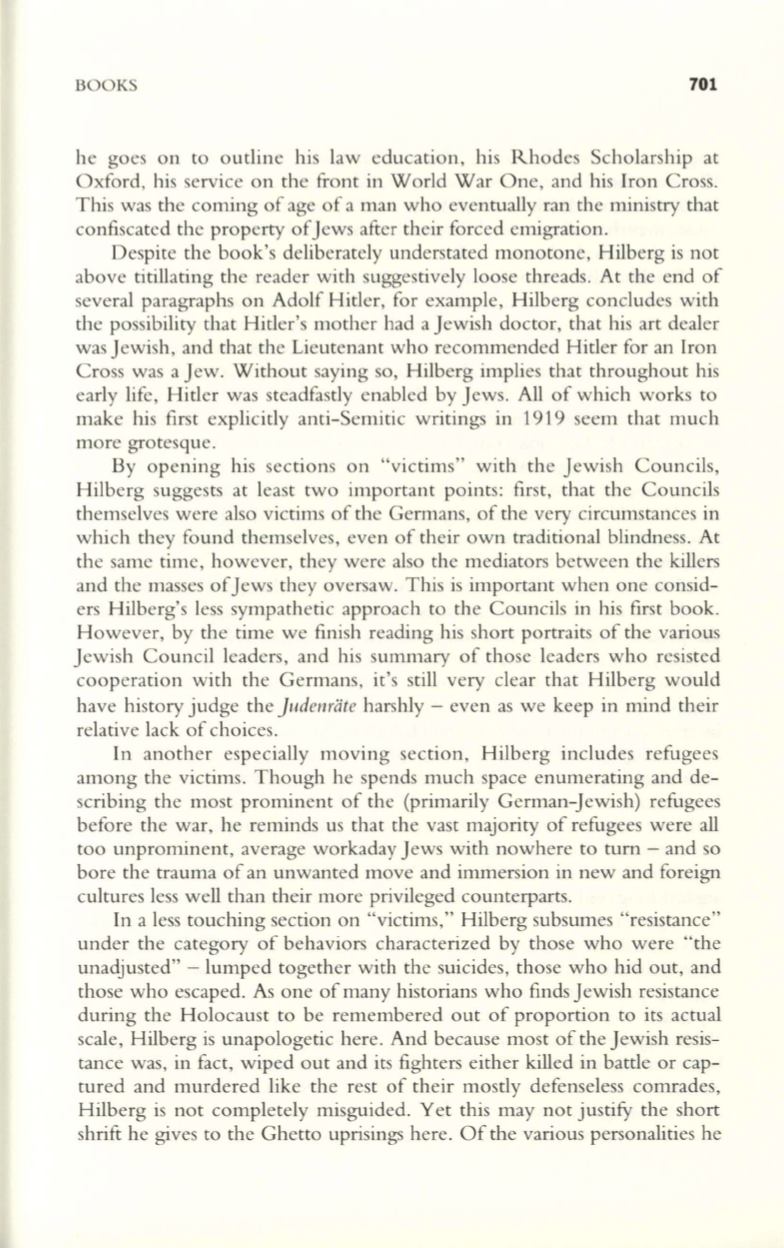
BOOKS
701
he goes on to outline his law education, his Rhodes Scholarship at
Oxford, his service on the front in World War One, and his Iron Cross.
This was the coming of age of a man who eventually ran the ministry that
confiscated the property ofJews after their forced emigration.
Despite the book's deliberately understated monotone, Hilberg is not
above titillating the reader with suggestively loose threads. At the end of
several paragraphs on Adolf Hitler, for example, Hilberg concludes with
the possibility that Hitler's mother had a Jewish doctor, that his art dealer
was Jewish, and that the Lieutenant who recommended Hitler for an Iron
Cross was a Jew. Without saying so, Hilberg implies that throughout his
early life, Hitler was steadfastly enabled by Jews. All of which works to
make his first explicitly anti-Semitic writings in 1919 seem that much
more grotesque.
By opening his sections on "victims" with the Jewish Councils,
Hilberg suggests at least two important points: first, that the Councils
themselves were also victims of the Germans, of the very circumstances in
which they found themselves, even of their own traditional blindness. At
the same time, however, they were also the mediators between the killers
and the masses ofJews they oversaw. This is important when one consid–
ers Hilberg's less sympathetic approach
to
the Councils in his first book.
However, by the time we finish reading his short portraits of the various
Jewish Council leaders, and his summary of those leaders who resisted
cooperation with the Germans, it's still very clear that Hilberg would
have history judge the
JI4denriite
harshly - even as we keep in mind their
relative lack of choices.
In
another especially moving section, Hilberg includes refugees
among the victims. Though he spends much space enumerating and de–
scribing the most prominent of the (primarily German-Jewish) refugees
before the war, he reminds us that the vast majority of refugees were all
too unprominent, average workaday Jews with nowhere to turn - and so
bore the trauma of an unwanted move and immersion in new and foreign
cultures less well than their more privileged counterparts.
In
a less touching section on "victims," Hilberg subsumes "resistance"
under the category of behaviors characterized by those who were "the
unadjusted" - lumped together with the suicides, those who hid out, and
those who escaped. As one of many historians who finds Jewish resistance
during the Holocaust to be remembered out of proportion to its actual
scale, Hilberg is unapologetic here. And because most of the Jewish resis–
tance was, in fact, wiped out and its fighters either killed in battle or cap–
tured and murdered like the rest of their mostly defenseless comrades,
Hilberg is not completely misguided. Yet this may not justifY the short
shrift he gives to the Ghetto uprisings here. Of the various personalities he


